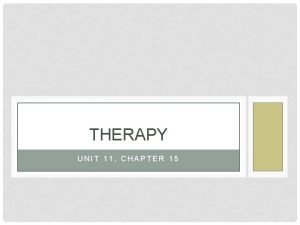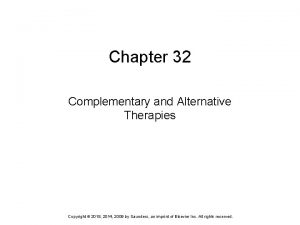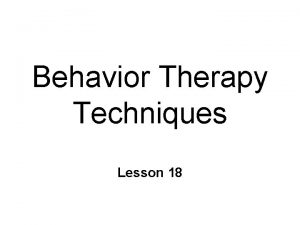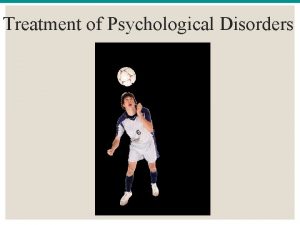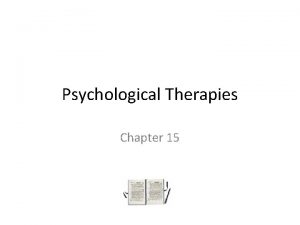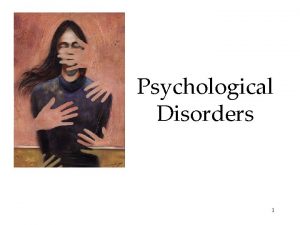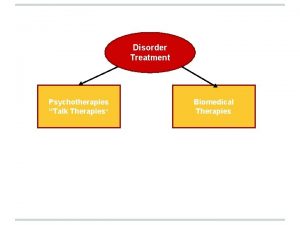The Challenge of a psychological therapies service in





















- Slides: 21

The Challenge of a psychological therapies service in an acute in-patient unit. Isabel Clarke and Hannah Wilson Clinical Psychologists from AMH Woodhaven.

The challenge of therapy delivery q. Variable and unpredictable admission times q. Mixed diagnoses q. Time of crisis q. Risk factors

The challenge of working with the system q. Combining psychological with medical approaches q. Developing therapeutic skills across the board q. Having an impact on milieu and morale

The challenge of evaluating the work. Finding a way to measure the impact of the psychological therapy; routine interventions also contribute to symptom change, therefore before and after symptom measurement is not indicative of effectiveness.

The Challenge of Therapy Delivery. § The key features of the Woodhaven therapeutic approach are as follows: § Simple formulation based on relationship to emotion, informed by the ICS split between the emotional and logical systems. (Interacting Cognitive Subsystems: see Teasdale & Barnard 1993) § A “Third Wave” Cognitive therapy – focus on intervening between thought and feeling rather than altering thought to effect feeling (see Hayes et al. 1999) § Management of arousal (breathing control), and mindfulness training to facilitate intervention in the cognitive/emotional process.

Key features cont. § Techniques of meeting, expressing and letting go of emotion as opposed to the previous avoidance. § This draws on Linehan's (1993) approach and has similarities to Emotion Focused Therapy (Greenberg 2002). § Practical discussion of lifestyle management to ensure the continuation of a better adjustment. § All these features are designed to enable someone to take control of their own recovery – in sympathy with the Recovery Approach (e. g. Repper & Perkins, 2003).

Typical formulation PAST ABUSE LOSSES PARTNER LEAVING Nightmares: can’t sleep Cut self Attempt suicide FEAR RAGE SADNESS Friends and family alarmed. Could lose custody of children. Feel worse More difficult to cope Avoid going out and seeing people More time to brood WAYS FORWARD Don’t let the feelings be in control: YOU ARE IN CHARGE Do things despite the feeling Breathing and mindfulness to get back to the present Use the energy of the anger positively

Working with the Institution. § Service users in crisis have a need to ‘make sense’. § Staff also need to ‘make sense’. § Reflection in the face of crisis and risk needs the skills of psychological thinking. The Psychological Therapies Service can support, develop and inform this psychological thinking. § In Woodhaven, this is achieved by: § Joint psychological assessment with key-worker. § Supervision of joint psychological work.

Further working with the Institution § Weekly Reflective Practice Groups for each ward, for the nursing staff, facilitated by a psychologist. § Co-facilitated, multi-disciplinary group work with a psychological focus. § Psychology-led training for staff group on developing strengths based care planning for the most challenging clients. § Training has lead to request for regular multidisciplinary care planning meetings (to be implemented)

Evaluation of the Individual Therapy Service. This was set up by Caroline Durrant (Assistant Psychologist), and conducted while she was with us (between September 2004 and March 2005). The period measured intensively was short because of the short duration of this support. Abigail Tolland (who worked briefly with us as an honorary assistant psychologist), assisted with the analysis of the data.

Principles behind design of the evaluation. § Designed to measure the intervention described above. § Measurement of symptom change not useful for evaluation because of concurrent interventions (medication etc. ). § Self efficacy and management of emotions are the aims of the intervention, hence they are evaluated. § Measurement of individual Goal achievement.

Measures 1. CORE - to measure level of psychopathology rather than change. 2. Mental Health Confidence Scale (MHCS) (Carpinello, Knight, Markowitz & Pease, 2000) The MHCS measures self-efficacy in relation to mental health. It is a sixteen item scale that measures three factors: confidence in the development of hope, confidence in the ability to manage symptoms and emotions, and confidence in the ability to advocate for one’s needs and rights. For each item scores are indicated on a Likert scale ranging from 1 = not confident to 6 = very confident. Total scores are gained by the sum of the items. It has high construct validity and low error variance making it a reliable measure.

Measures cont. 3. Locus of Control of Behaviour Scale (LCB) (Craig, Franklin & Andrews, 1984) The LCB scale is a seventeen item scale focusing on perceived control over mental health problems. Each item is rated using a 6 point Likert scale where 0 = strongly disagree and 5 = strongly agree. The scale is a reliable and valid measure with clinical samples. 4. Goal Setting: Visual-analogue, ideographic, measure of individual goals.

Measures cont. 5. Living with Emotions The Living with Emotions measure was designed for this research. It consisted of three questions looking at confidence in coping with emotions. Each question is scored on a Likert scale to allow for accurate before and after comparison. The scales range from 0 = not at all confident to 10 = extremely confident. Total scores are calculated using the sum of the items. Beneath the scales is a fourth closed question asking about efficacy of techniques for coping and an open question concerning which techniques are most useful. Carpinello, S. E. , Knight, E. L. , Markowitz, F. E. & Pease, E. L. (2000) The development of the mental health confidence scale: A measure of self-efficacy in individuals diagnosed with mental disorders. Psychiatric Rehabilitation Journal 23 pp 236 – 243 Craig, A. R. , Franklin, J. A. & Andrews, G. (1984) A scale to measure locus of control of behaviour. British Journal of Medical Psychology 57 pp 173 -180

Results q Pre and post therapy scores suggest that service users felt: q more able to cope with their mental health difficulties q had a greater internal sense of control q felt more confident in dealing with their emotions q felt more confident in employing strategies to deal with strong emotions.

SUMMARY AND CONCLUSIONS 1. Psychological services can contribute to developing a therapeutic milieu in an in-patient acute setting in a number of ways: staff support and training reflective practice, on-going supervision, group and individual therapy 2. Service users report increased confidence and coping after very brief psychological therapy

Directions for the Future 1. Ongoing evaluation of the brief individual therapy. 2. Working with new teams: The same model is being extended to Crisis Resolution Home Treatment and Assertive Outreach Teams and will be evaluated. This will facilitate smoother psychological working across discharge. 3. Evaluation of the impact of these approaches upon on re-admission rates over time.

Directions for the Future cont. 4. Continuing development of the multidisciplinary DBT programme, its evaluation and application across diagnoses. 5. Evaluate the impact of psychology led reflective practice on nursing practice, staff morale, ward atmosphere etc. 6. Evaluate the impact of psychology led training on ward practice.

Development of a DBT in-patient service § A psychology led, multi-disciplinary team at Woodhaven are trained in DBT. The team are implementing an adapted programme for the unit which includes: § 1: 1 weekly therapy following the DBT model § Individual skills training § 6 week Emotional Coping Skills (ECS) group § Chain analysis after incidents of self harm § Risk management advice § Staff training and education § Consult team for support and supervision

Evaluation of DBT service. Evaluation of the programme includes the Mental Health Confidence Scale (MHCS), Work and Social Adjustment Questionnaire and Living with Emotions (LWE) questionnaire. Outcome data for the first year of the ESC group are positive:

Contact Details and References • Isabel. Clarke@hantspt-sw. nhs. uk • Hannah. Wilson@hantspt-sw. nhs. uk • Durrant, C. , Clarke, I. , Tolland, A. & Wilson, H. Designing a CBT Service for an Acute In-patient Setting: A pilot evaluation study. Accepted subject to amendment by Clinical Psychology and Psychotherapy. • Forthcoming book: Cognitive Behaviour Therapy for Acute Psychiatric Inpatient Units; working with clients, staff and the milieu. Edited by Isabel Clarke & Hannah Wilson. Routledge. • Plans for a Symposium on CBT for inpatient units at the forthcoming BABCP conferences. • Isabel’s website: www. scispirit. com/Psychosis_Spirituality/
 Psychodynamic vs psychoanalytic
Psychodynamic vs psychoanalytic Trafford psychological therapies
Trafford psychological therapies Trafford psychological therapies
Trafford psychological therapies Trafford psychological therapies
Trafford psychological therapies Trafford psychological therapies
Trafford psychological therapies Teen challenge nottingham
Teen challenge nottingham Module 73 the biomedical therapies
Module 73 the biomedical therapies Biomedical therapy
Biomedical therapy Stiriti ayur therapies private limited
Stiriti ayur therapies private limited Talking therapies westminster
Talking therapies westminster Biomedical therapy techniques
Biomedical therapy techniques Advanced therapies apprenticeship community
Advanced therapies apprenticeship community Chapter 32 complementary and alternative therapies
Chapter 32 complementary and alternative therapies Flooding therapy example
Flooding therapy example Humanistic therapies aim to boost
Humanistic therapies aim to boost Psychodynamic and humanistic therapies have in common
Psychodynamic and humanistic therapies have in common Biomedical therapy definition
Biomedical therapy definition Astellas gene therapies
Astellas gene therapies Pvu
Pvu Bodywork and movement therapies
Bodywork and movement therapies Insight therapies involve verbal interactions
Insight therapies involve verbal interactions Therapies that directly affect the biological functioning
Therapies that directly affect the biological functioning
